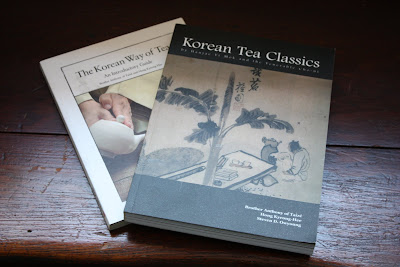
On this cool early autumn day, with water boiling, lets sit down, slow down, and enjoy some tea...

The first infusion is prepared with just off boiling water. A fresh, malty chalkiness lightly coats the whole mouth with a lingering vanilla note. It has much flavour to pick on with a baked spicy and very light, sweet fruity notes apparent as well. The flavour and feel has an aged hardiness to it yet still retains its elegance. The thick but very slight aftertaste stays around for a long time while transmitting more of the dominant vanilla, and now, coca sweetness. A sweat breaks instantly. The chaqi moves, rises, disperses- the light, aromatic, floating, dispersing energy is powerful and calming. It's direction is quickly outward and upward. Ones forehead immediately perspires.

In the second infusion malty-thick, viscous, slippery flavours slide over the mouth- completely embracing it. A light sweetness with thick malty bottom comes over the mouth like a wave leaving behind the deep, mysterious, and chalky. Light into dark, light into deep, summer into fall. The tea reaches deep into the throat. The aftertaste is just a continuation of the initial sip.
The third infusion has an initial flavour that bends to more of a caramel-maltiness. There is a fresh quality that presses against the heavy, viscous bottom of this tea. A gritty, chalky nature is revealed in the full mouthfeel and throatfeel of this tea. The chaqi induces a sweat every time the first cup of a new infusion is consumed. Besides dispersing up and outward, the chaqi also warms and strengthens the middle jiao as it slowly creates a comforting warming sensation in the guts.

The fourth infusion has the vanilla notes more prominent. The taste becomes a bit more creamy with deeper notes becoming less overpowering. The mouthfeel becomes more sticky and slick. The aftertaste is as full as ever with chocolate vanilla notes burrowing deep into the throat.
The fifth infusion tastes lighter and fresher with ghostly, but still very present, deeper notes hanging on. The finish is still that sweet, light, ethereal, vanilla coco. The mouthfeel is thinner initially and thickens out in the throat. The qi here is warming and disperses slower now. A hot flash now hits the head minutes after finishing the pot. Now the warming- middle nature of the chaqi is more predominant over the dispersing nature.
In the sixth and seventh infusions the tea develops a woody, slightly spicy character with the vanilla and chocolate notes just present as a back taste. It finishes dry and slightly bitter. The mouthfeel is lighter and sharper. The aftertaste is deliciously long and starts to develop a sharp tartness. The flash of heat comes much later and is just slightly noticeable now. Strong relaxation is induced.

This tea is taken a few more infusions. This last push contains sharper, thinner flavours of spicy wood with even some subtle fruity notes.
Peace















